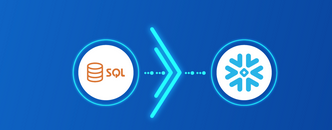In the evolving landscape of data analytics and warehousing, a significant shift has been observed: businesses are moving from traditional databases, like Microsoft’s SQL Server, to cloud-based platforms like Snowflake. The migration from SQL Server to Snowflake is driven by the desire for scalability, elasticity, and performance. However, many enterprises find themselves asking, “How do I seamlessly see and transfer my data from SQL Server to Snowflake?” Let’s dive into a step-by-step guide for this transition.
-
Table of Contents
Understand the Motivation:
Before delving into the migration process, it’s vital to comprehend why Snowflake is gaining popularity:
Elastic Scalability: Snowflake offers effortless scaling, allowing businesses to handle varying workloads efficiently.
Concurrent Access: Multiple users can query data simultaneously without impacting performance.
Zero Maintenance: Snowflake requires no maintenance, enabling IT teams to focus on data-driven tasks rather than infrastructure issues.
-
Pre-Migration Steps:
Assessment: Review your existing SQL Server data structure. Identify tables, schemas, and other database objects that need to be transferred.
Data Cleanup: This is an opportune moment to remove outdated or unnecessary data, ensuring a streamlined migration.
Schema Conversion: Snowflake has a unique data warehousing architecture. Tools like SnowConvert can help you convert SQL Server T-SQL code to Snowflake syntax.
-
Migrating the Data:
ETL Tools: Leveraging ETL (Extract, Transform, Load) tools, like Stitch or Fivetran, simplifies the migration process. They extract data from SQL Server, transform it as required, and load it into Snowflake.
Bulk Data Loading: Snowflake supports bulk loading through the SnowSQL CLI client. The data from SQL Server can be exported into flat files, and Snowflake’s COPY INTO command can be used to load these files.
-
Post-Migration Steps:
Verification: After transferring, it’s essential to verify if all data has been migrated accurately. Check for data consistency between the SQL Server and Snowflake tables.
Optimization: Snowflake provides various optimization features like clustering. Make sure to utilize them to ensure efficient query performance.
Update ETL Pipelines: If you have existing ETL jobs running on SQL Server, update them to direct data to Snowflake.
-
SQL Server vs. Snowflake – Embracing Change:
While SQL Server has served many businesses faithfully over the years, the scalability and performance of Snowflake in the cloud environment are hard to overlook. However, this transition might require changes in how SQL queries are written, given the differences in SQL dialects.
-
Training and Skill Development:
It’s important to understand that while the core concepts of data management remain consistent, the specific mechanics between SQL Server and Snowflake can differ. Therefore, once the migration decision is made, invest in training sessions for your IT and data teams. Comprehensive workshops can aid in understanding Snowflake’s functionalities better, ensuring that your team can handle the new environment without hitches.
-
Cost Considerations:
Moving to a cloud-based platform often comes with cost implications. It’s essential to conduct a thorough cost-benefit analysis. Snowflake’s pay-as-you-go pricing model can be a boon for many, ensuring you only pay for the storage and computing resources you use. Planning budgets in advance, considering data storage, query execution times, and virtual warehouses, can prevent unexpected expenses.
-
Security Protocols:
Snowflake offers robust security features, including automatic encryption, multi-factor authentication, and role-based access controls. While migrating, ensure that you map the security roles from SQL Server to equivalent roles in Snowflake. Establishing a secure pipeline during the transfer of data also ensures that sensitive information remains uncompromised.
-
Future-Proofing with Continuous Integration/Continuous Deployment (CI/CD):
Modern businesses thrive on agility. Implementing CI/CD pipelines for your Snowflake environment means that changes to your data infrastructure, be it in the form of new analytics models or updated data processes, can be rolled out swiftly and smoothly. Integrating tools like Git can provide version control, ensuring any changes made are tracked and can be rolled back if necessary.
-
Monitoring and Maintenance:
Even though Snowflake boasts zero maintenance, monitoring your data workflows is always a good practice. Setting up monitoring alerts for any discrepancies, performance bottlenecks, or failed ETL jobs ensures you’re always on top of your data game.
Further Reflections:
While migration can seem daunting, the technological and strategic advantages that Snowflake offers can profoundly impact an organization’s efficiency and decision-making prowess. By ensuring a meticulous, well-planned move, businesses can unlock a plethora of opportunities in analytics, machine learning, and real-time data processing. The key lies in understanding that migration is not an end but the beginning of a journey towards more robust, scalable, and efficient data-driven decision-making. Embrace the change, and let your data shape your future.
















